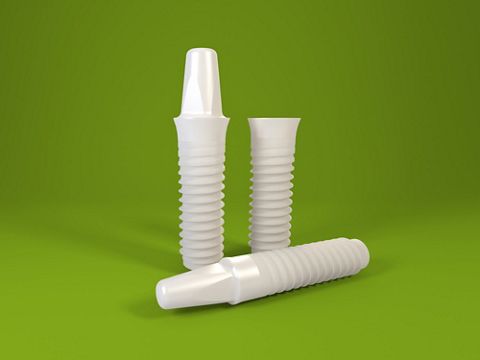Insertion of a Straumann® PURE Ceramic Implant through the DWOS Synergy™ workflow with immediate digital provisionalization
Clinical case report by Richard Zimmermann and Stefanie Seitz, USA
The Straumann® PURE Ceramic Implant has a natural looking ivory color. This specific feature makes the implant look more like a natural tooth and it supports the clinician in cases of thin gingiva biotype or soft tissue recession. It has a monotype design based on features of the Straumann® Soft Tissue Level Standard Plus and Straumann® Bone Level Implants. (Product information by the manufacturer)
Initial situation
A 30 year old female with non-contributory medical history presented to the clinic for evaluation of a maxillary edentulous site. Review of her dental history revealed that tooth #12 (ADA) was lost due to failed endondontic therapy approximately a year ago during her pregnancy and she was now ready to have it replaced. She presented with a high smile line, medium-scalloped gingiva with medium thickness and a desire not to have any metal in her oral cavity. When discussing the various options regarding implant therapy, the patient was very interested in being evaluated for an all ceramic implant. On January 11, the FDA cleared the Straumann® PURE Ceramic Implant for use within the US. Though new to the US, European case documentation has shown excellent osseointegration and soft tissue response. The Straumann® PURE Ceramic Implant is a monotype style implant, meaning the abutment and implant body are one-piece.
Treatment plan
The patient was sent to get a computerized cone beam tomography (Morita, USA) of the area and digital diagnostic impressions were taken using an intra-oral scanner (3Shape Trios 3). Once obtained, the DICOMs were imported into the implant planning software (coDiagnostiX™) while the scan files were imported into the laboratory software (Straumann® CARES® Visual) (Figs. 1,2). Since the Straumann® PURE Ceramic Implant are monobody in design and it is not recommend to modify the abutment, the DWOS Synergy™ workflow was utilized to virtually plan this case. DWOS Synergy™ provides real-time communication between the implant planning software (coDiagnostiX™) and the lab software (Straumann®CARES®Visual). This feature improves implant planning by allowing the visualization of the relationship between the proposed implant position and the proposed restoration. Modifications made to the implant position or restoration design are immediately transferred to the other software, providing instantaneous feedback on how the modification of one affects the other. Of special interest in regard to the Straumann® PURE Ceramic Implant, is that one can design the restoration and ensure that the planned position will not require modification for restorative materials. Once the planning was complete, both the surgical guide and the provisional designs were sent off for fabrication. The guide was sent to a lab to be printed by an Objet30 OrthoDesk (Stratasys) while the provisional file was sent to Straumann Milling Center in Arlington to be fabricated out of polycon ae (PMMA) (Figs 3, 4). During the surgical planning utilizing the DWOS Synergy™ workflow, a Straumann® PURE Ceramic Implant (4.1x12mm) was selected with an abutment height of 5.5 mm.
Surgical procedure
The Straumann® PURE Ceramic Implant design is a combination of the tissue level and bone level implant – the neck of the implant mirrors the Straumann® Tissue Level implant while the implant body mimics the Straumann® Bone Level design (Fig. 5). As such, the surgical protocol for preparing the osteotomy for the PURE is the same as the corresponding Bone Level implant. For this case a guide was used to prepare the osteotomy following the protocol set forth for Bone Level implants given by coDiagnostiX™. Though this case was performed with Straumann Guided Surgery (SGS), a small flap was made to ensure the desired position of the Straumann® PURE Ceramic Implant shoulder. SGS utilizes different combinations of sleeve positions, drill lengths and drill handles to prepare the osteotomy to the correct depth. Sleeves can be placed at three different heights from the implant level (2, 4 or 6mm) based on the case and surgeons preference. The combination of drill length (short, long or extra-long) and drill handle (1mm or 3mm) are determined by the implant planning software which provides the surgical protocol to use at time of surgery. The Straumann® PURE Ceramic Implant system uses a series of “position indicators” that aid in ensuring the correct position of the implant during surgery. Both abutment diameters and heights have corresponding position indicators that are placed into the osteotomy for evaluation (Fig. 6). Once the osteotomy has been prepared, typically a surgeon will use a “guided implant”, which has a unique driver, to ensure proper placement of the implant. However, the Straumann® PURE Ceramic Implant currently does not have such a driver therefore the surgical guide was only used to prepare the osteotomy while implant placement was performed free-hand. Bone quality was determined to be Type II. The Straumann® PURE Ceramic Implant comes with a separate transfer piece for placement which snaps into place much like the Tissue Level impression cap. Three dots on the driver line up with a flat surface of the abutment portion of the implant and also indicate distance to the shoulder (1, 2 and 3mm). The implant was placed without any incidence to the desired depth and position of the dots (Figs. 7-9). During the healing phase, a protective cap is placed over the abutment to protect it. Since the patient was concerned with esthetics and has a high smile line, it was decided to place a provisional to provide more esthetic appearance. The recommendation by Straumann not to immediately load a PURE implant was taken into account during the DWOS Synergy™ design session by eliminating occlusal and lateral contacts. This provisional was then further modified at time of surgery by further reducing the anatomy and creating more of a custom healing abutment than immediate provisional. The provisional was cemented using temporary cement (TempBond, Kerr) and only two interrupted sutures were required to secure the flap. At the one-week follow up the tissue was healing beautifully around the implant and the patient was scheduled for the final impression seven weeks out (Fig. 10).
Final result
The patient was in slight discomfort following the surgery, but stated that this surgery was less painful than the previous extraction. She was pleased to have the modified provisional versus a dark space in her smile.
"As implant therapy has evolved, patient expectations have risen. The desire to have a natural looking, metal-free restoration is increasing as can be seen by the decrease of metal substructures for crowns and frameworks and the increase in ceramic restorations."
Conclusion
Since the Straumann® PURE Ceramic Implant endosteal portion is based on the Straumann® Bone Level design, it does not require additional surgical instruments or drilling protocols for placement while the specialized transfer piece comes with the implant. When placing the driver onto the Straumann® PURE Ceramic Implant abutment care must be taken to align the indicator dots up with the facets, otherwise incomplete seating of the driver may occur (Fig. 11). As implant therapy has evolved, patient expectations have risen. The desire to have a natural looking, metal-free restoration is increasing as can be seen by the decrease of metal substructures for crowns and frameworks and the increase in ceramic restorations. While titanium can cause a graying of the tissues, the ivory coloring of the Straumann® PURE Ceramic Implant can provide a more esthetic outcome. Another patient was ecstatic to have the option for a Straumann® PURE Ceramic Implant implant since her husband has a titanium implant in the anterior region and she can see the gray. All ceramic implants have the potential to provide greater esthetic outcomes but do require more precise planning and placement. Initially one might consider the Straumann® PURE Ceramic Implant to be limited by design, to a degree it is, however the DWOS Synergy™ workflow can help to reduce the challenge of placing a monotype implant.



